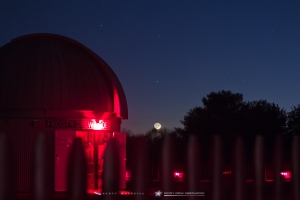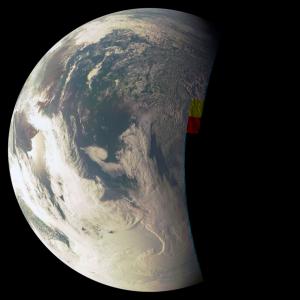
Summer Stargazing Nights
- Where:
- Frosty Drew Observatory
- When:
- Friday June 10, 2016 at 7:30 p.m.
- Cost:
- $1 Suggested Donation per Person
Tonight is Stargazing Night at Frosty Drew Observatory and forecasts are calling for partly cloudy to most clear skies. We may see some fog roll in in the early morning hours, though at this point there is a measure of variability in the forecast. It's important to note that nearly all forecasts recently that have a measure of variability have always turned out in our favor. Add in that the 39% waxing crescent Moon will be with us at sunset and will slowly descend toward the Western horizon until 12:30 a.m. when it will set. Though a bit bright, the Moon will offer up stunning views of the lunar surface and will not obscure our view of Jupiter, Mars, and Saturn; which will all look fabulous! Once the Moon sets, the fabulous Milky Way will blaze the sky if clouds can stay minimal. Making tonight a potentially great night.
We will open the Observatory and Sky Theatre at 7:30 p.m. In the Observatory we will start with a dusk view of Jupiter and the four Galilean Moons followed by the Moon. Once Mars and Saturn rise high enough over the horizon, we will showcase these fabulous planets. Saturn's rings will look amazing in the Frosty Drew telescope! The Sky Theatre will feature a showcase of celestial objects photographed at Frosty Drew Observatory and will be open until 11:30 p.m. We will also have the Nature Center open from 8:30 – 10:00 tonight with Frosty Drew Naturalists on hand to answer questions and showcase the daytime side of Frosty Drew.
Overall, tonight could turn out great. Partly cloudy skies could go either way, though we will put a best effort attempt out there and hope the sky responds with awesomeness. If clouds are more frequent, we can always fall back on views of the crescent Moon in between passing clouds. Checking in on our Twitter (@FrostyDrewOBSY) and Facebook will keep you updated on what is happening at the Observatory, with posts describing what we are looking at and how sky conditions are affecting us. So swing by and check out Jupiter, Saturn and the Moon while chatting with our astronomers about how awesome the Universe is and have a late spring astro-geek-out compliments of the cosmos.
-------------------------------------------------------------------------
Weekly Happenings
Scott MacNeill
On the night of July 4, 2016, the NASA Juno spacecraft will fire its main engine, inserting itself into a polar orbit around Jupiter. Tasked with an impressive checklist of science awesomeness, Juno will attempt to reveal the origins and evolution of the massive gas giant and in doing so will help us better understand the beginnings of the solar system.
The second spacecraft designed under NASA's New Frontiers program (New Horizons is the first), Juno launched from Cape Canaveral on August 5, 2011, embarking on its 5 year journey to Jupiter. Grabbing a quick gravity assist from Earth on October 9, 2013 gave Juno an inexpensive boost in speed. Juno will have traveled 1.7 billion miles at the time of orbital insertion in July 4th.
Juno's mission will help answer many basic questions we have about Jupiter. Does Jupiter have a solid core, like Earth? If so, how big is it? How much water exists in Jupiter's atmosphere? What do the polar regions look like? These questions along with others about Jupiter's magnetic field, atmospheric rotation, auroras, and the structure of Jupiter's interior will help us better understand the formation and evolution of Jupiter and other gas giant planets.
To accomplish the mission goals, Juno will assume an elliptical polar orbit with very close passes happening on a regular basis. These passes will take Juno through the hazardous radiation belts that make up Jupiter's magnetosphere. Having an elliptical orbit will allow Juno to avoid the most dangerous radiation belts by approaching Jupiter at the north polar region, performing its low altitude pass on a southerly heading and depart over the south polar region. The spacecraft will complete 33 of these orbits over a one year period, passing at altitudes as low as 3,100 miles over Jupiter's cloud tops every 11 days. After which, the 34th orbit will have an altitude adjustment placing Juno on a trajectory to enter Jupiter's cloud tops at 34° north latitude. Juno will not be able to withstand the density and heat of Jupiter's atmosphere and will burn up shortly after entry.
Juno is yet another excellent example of the fabulous science we are capable of accomplishing. Learning about the formation and evolution of the largest planet in the solar system will help us understand our origins. Jupiter's giant mass allowed it to retain its original composition, locking away secrets to the processes and conditions of a solar system in formation. These secrets will offer us another method to trace the solar system's history and narrow down our theories on what happened shortly after the formation of the Sun. Check out the Juno mission and get excited for the July 4th arrival of the 9th spacecraft to visit Jupiter.
On Wednesday, June 1st, the skies over Frosty Drew Observatory opened up offering us a fabulous night out under the stars. Over the course of the night we captured many amazing views of the cosmos including a fabulous capture of the beautiful binary star system Nu Draconis. Found in the constellation Draco, Nu Draconis resides at a distance of 99 light years. Both stellar components are spectral type A, making them mostly white with a slight blue hue both equaling about 1.7 times the mass of the Sun and 9 times as bright. Both stars share a distance of 1,900 AU apart (1 AU is the distance of Earth from the Sun). At this distance and mass, both stars would shine in each others sky about three times the brightness of the full Moon and complete one orbital period around their common center of mass (barycenter) every 44,000 years. Nu Draconis is naked eye visible as one star and easily visible as a binary in modest backyard telescopes and a good pair of binoculars. Check out our photo:
-Scott



